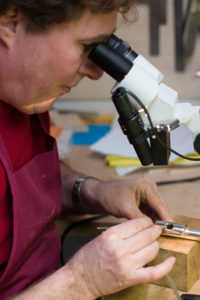One of the secrets of flute embouchure cutting is the edge. The adges are rounded off slightly. The way this is done has a huge influence on tone quality and response. The sharpest edge is the blowing edge. It is the place where the stream of air from your lips decides to go up or down
Till that point, it is what is called in terms of liquid dynamics a laminar flow. If the air goes up, it will bump into the outside air, breaking up in smaller and smaler eddies (vertices) until all energy is dissipated. The energy from the bump travels as a sound wave through the air and is part of the tone. Turbulence from the eddies also becomes part of the tone.
If the airstream decides to go down, it will give a push to the wave that bounces up and down the flute bore, much like you push a swing.
Leaving the blowing edge sharp gives great dynamics, but a rough and uncontrollable tone. Rounding off too much gives a steadier tone, but not too much or it will loose all flexibility. The biggest file I use for this work is a so called escapement file, which is incidentally the finest file one can buy.

